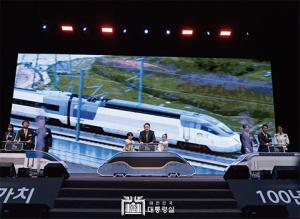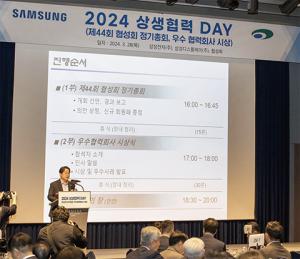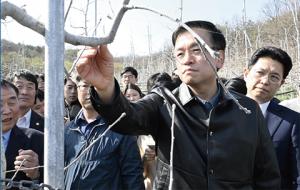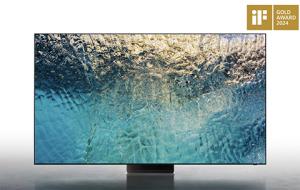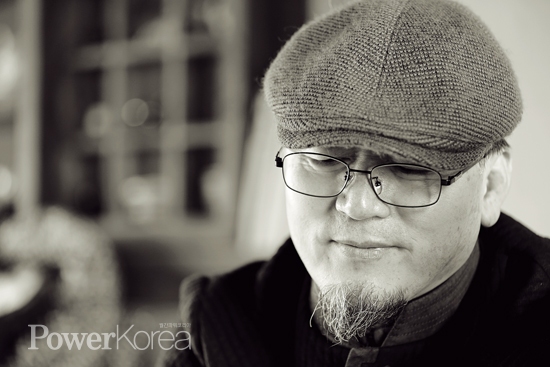 |
||
부드러운 한지 위에 사진의 감성을 담다, 지숨 갤러리
지숨 갤러리 황용운 대표
한지(韓紙)를 만드는 데에는 오랜 시간과 정성이 필요하다. 깨끗이 다듬은 닥나무 껍질을 벗겨 건조시키고, 이를 잘 삶아낸 뒤 돌판에서 두드려 섬유를 펴낸다. 이 닥섬유를 닥풀과 섞어 바탕을 떠내고, 물기를 뺀 다음 다시 건조시키는 과정을 거친다. 이렇게 탄생한 한지는 그 특성 탓에 ‘빛과 바람을 엮어낸 종이’라고도 부른다.
첨단과 전통의 만남, 세계 최초 한지 인화기술 개발
동양의 격언 중에 ‘비단은 오백년을 가지만, 한지는 천년을 간다’는 말이 있다. 값비싼 비단에 비견될 정도로 우리민족 고유의 종이인 ‘한지(韓紙)’는 그 우수성을 널리 인정받아왔다. 부드러우면서도 질기고, 투과성이 뛰어나면서도 강인한 성질을 가진 한지는 서화(書畫)를 담기위한 서적은 물론이고, 여러 겹 붙여 장판지나 가구, 생활용품으로 활용되기도 했으며, 더위와 추위를 조절하기 위한 문종이로 쓰이기도 했다. 그러나 이처럼 수천 년간 우리 민족의 삶과 함께해 온 한지도 1970년대 이후 사양길에 접어들었다. 제조방법이 어렵고 까다로워 한지를 만드는 장인의 수가 감소했고, 값싸게 대량생산된 펄프지가 들어오며 그 쓰임 또한 줄어들었기 때문이다. 이제는 전통공예의 한 줄기로만 명맥을 이어오고 있는 한지에 다시금 숨을 불어넣고 있는 이가 있다. 바로 지숨갤러리의 황용운 대표다.
지숨갤러리의 ‘지숨’은 말 그대로 ‘종이가 숨을 쉰다’는 뜻이다. 황 대표는 “한지는 화학 약품으로 가공된 보급형 산성지와는 달리, 나무의 생명력을 그대로 간직한 채 천년 이상 숨을 쉬는 종이입니다. 섬유질이 고르고 견고해서 찢겨짐 같은 훼손에도 강하고, pH 7.0의 중성을 띄고 있어 오랜 시간이 지나도 열화 되지 않습니다”라고 설명했다. 이러한 특성에 주목한 황 대표는 우수한 우리 종이인 한지를 다시 부흥시키고, 보편적으로 활용할 수 있는 방법을 모색하던 중 사진 인화지로서의 가능성을 발견하게 된다. 촘촘한 섬유의 결이 그대로 묻어나는 한지 특유의 질감과 부드러움이 사진에서 고유한 영역을 구축할 수 있으리라 본 것이다.
그러나 그 과정은 결코 순탄치 않았다. 섬유의 결이 살아있는 한지의 특성이 오히려 사진 인화에는 부적합했기 때문이다. 그는 “불규칙한 표면을 가진 한지에 글씨와 단색 그림을 인쇄할 수는 있어도, 컬러 사진을 인쇄한다는 것은 매우 어려운 일이었습니다. 원본 사진의 상태를 정확하게 구현하기 위해선 인화액으로 가공된 종이가 필요하다는 것이 일반적이었고, 한지의 경우 번지는 속성 탓에 사진 프린팅이 어려워 많은 이들이 시도했지만 성공하지 못했었습니다”라고 말했다. 4년여 간의 연구 끝에 황 대표는 해결책을 개발해냈다. 억지로 색상을 입히기보다는 스미는 방식 그대로를 살렸고, 종이에 뿌려진 잉크가 번지기 전에 빠른 속도로 말리는 기술을 적용해 프린팅을 가능케 한 것이다. 화학첨가물 없이 만든 전통한지에 사진을 인화하는 기술을 세계 최초로 개발한 황용운 대표는 이를 발판삼아 벤처 기업 ‘지숨’을 설립했다.
전통의 진정한 가치, 한지의 세계화를 꿈꾸다
황용운 대표가 개발한 한지사진은 수많은 국내외 전시회 및 초대전을 통해 커다란 호응을 이끌어 냈다. 일반 인화지에서는 표현할 수 없는 부드럽고 따뜻한 질감과 우아한 색감을 가지고 있으며, 마치 그림과도 같은 회화성을 통해 그 안에 담긴 풍부한 감성이 잘 전달되어왔기 때문이다. 그는 미국과 중국, 홍콩 등에서 한지사진의 전시 일정을 진행했으며, 지난해 9월에는 ‘제14회 한국주간행사’에 초청받아 중국 학계와 예술계에 신선한 충격을 선사하기도 했다.
또한 제2회 대한민국사진축전, 북경 코리아아트 초대전, 뉴욕 Coohaus 갤러리 초대전 등 국내외 전시전에 참가한 황 대표의 사진작품 15점과 한지를 활용한 상품들이 전시되어 있는 한지포토 문화공간 ‘지숨갤러리’는 전주한옥마을을 방문한 이들이 필수적으로 들러야하는 코스 중의 하나로 자리매김했다. 지숨갤러리를 찾은 관람객들은 전시된 물품들의 사진을 찍거나 작품을 만져볼 수 있으며, 자신이 직접 찍은 사진을 한지에 인화해 갈수도 있다. 황 대표는 “아직까지도 대부분의 사람들은 한지를 단순히 ‘우리 선조들이 만든 종이’로만 인식할 뿐, 세계에서도 인정하는 그 우수성에 대해서는 잘 모르고 있습니다. 자신이 찍은 사진을 한지에 인화하는 낯설고도 새로운 경험을 통해 보다 많은 사람들이 한지의 진정한 가치와 우수성을 알게 되는 계기가 되었으면 하는 바람입니다”라고 밝혔다.
한지사진의 성공을 발판으로 10배가 넘는 놀라운 매출 성장을 기록하고 있는 ‘지숨’은 현재 국내 두 곳의 갤러리와 중국 전시관을 운영하고 있다. 올 초에는 신라면세점에 입점했으며, 향후 한지 연구소와 한지공장 신설도 계획되어 있다. 또한 관광객 확보와 한지 수급을 위해 전주 근교 지역 마을들에 닥나무를 심을 계획도 갖고 있다. 지숨이 거둔 성공이 여타의 그것과 다른 것은 전통문화의 보전과 계승이라는 차원을 넘어 새로운 가치를 발견하고 재창조해냈기 때문이다. 기념품으로 소모되거나 전시부스 안에서 박제되고 마는 전통문화가 아니라, 우리 생활 가까이에서 활용되는 한지문화의 부흥을 이끌고 있는 것이다. 황 대표는 “최근 전주한옥마을의 분위기가 퇴색됐다는 이야기가 많아졌습니다. 전통이라는 명분을 잃어버린 채 지나치게 상업적으로만 변해가고 있다는 것입니다”라고 지적하며, “저희는 한지를 통해 전통문화산업을 되살리고자 합니다. 전통기술자를 양성하고, 관련 문화상품을 개발함으로써 한지 산업의 규모를 키우는 것은 물론, 지역경제의 활성화까지도 가능하다는 것을 보여주고 싶습니다”라고 강조했다. 뿐만 아니라 국내 사진인화시장의 30%, 나아가 세계 시장 10% 점유를 달성해 한지의 세계화, 한국 전통문화의 세계화를 이뤄내겠다고 다짐했다. 전통문화란 낡고 오래된, 구시대의 유물이 아니다. 그 안에는 선조들의 놀라운 지혜와 첨단의 과학이 숨어있으며, 우리 민족의 자긍심과 정체성이 숨을 쉬고 있다. 한지의 가치를 재조명하고 재창조하기 위한 이들의 노력이 ‘대한민국’이라는 국가 브랜드를 세계에 인식시키는 밑거름이 되길 기대한다.
 |
Shift your photos on Korean paper
Zisum Gallery CEO Hwang Yong-woon
Introducing world’s first Korean paper printing technology
There is a saying ‘Silk lasts for 500 years but Korean paper for a thousand years’. Traditional Korean paper is sturdy and has good permeability. It has not only been used for calligraphy and painting but also in many household items: floor paper and paper laminated doors for example. However, the demanding making process of the paper and mass produced paper pulp brought a decline to the industry in the 1970s. The good news however is that there is a company that succeeds the tradition with contemporary ideas: Zisum Gallery. ‘Zi’ in Korean means paper and ‘sum’ breathing. Hwang explains “Unlike many other types of papers, Korean paper keeps the vitality of wood intact and it can last over a thousand years. The fiber of the paper is even and sturdy and is neutral with a pH 7.0 which makes it hard to be depleted. I made use of this excellent property of Korean paper by attaching a photo on it to create a unique form of decoration.” Hwang continues “I didn’t know at first how to stick a photo on a Korean paper that has uneven surface and high permeability. After 4 years of research and trials however, I found a solution: I used this permeability but dried up the ink quickly before it gets spread. In this way, I could shift a photo on to the paper and print it. It was the world’s first Korean paper printing technology and I eventually established the venture enterprise Zisum.
Globalizing Korean paper
Hwang’s Korean paper photographs attracted a great attention through exhibitions and fairs home and abroad including 2nd Korea Photograph Fair, Beijing Korean Art Invitation Exhibition, New York Coohaus Gallery Invitation Exhibition and Korea Week 2015. People from the world praised the paper for its smooth and warm texture and graceful colors. One might think of it as a painting. Hwang displayed 15 of his works and other Korean paper products at his Zisum Gallery in Jeonju Traditional Korean Village and it has become a must-visit place among tourists. You can touch the displays and take a photo of your own to make it into a Korean paper print in the place. Hwang says “Many Korean people still don’t know how much Korean paper is globally recognized today. I hope my business will take part in spreading excellence of Korean paper to more people.” With its 10 fold increasing sales, Hwang currently is running two galleries in Korea and an exhibition hall in China. Also, he secured a supply channel to Shilla Duty Free Shop early this year. As for the future plan, he is pushing forward the plan to build factory, open Korean Paper Research Center (tentative) and plant the paper mulberry around the village. Hwang says “There’s a feeling among people that the village has become too commercial. But developing more cultural products will be an effective way to give a balance between tradition and commercial.” When asked about his goal, Hwang said “My goal is to share 30% of the photographic printing market in Korea and 10% in the global market.
정재헌 기자 jjh05220@naver.com

